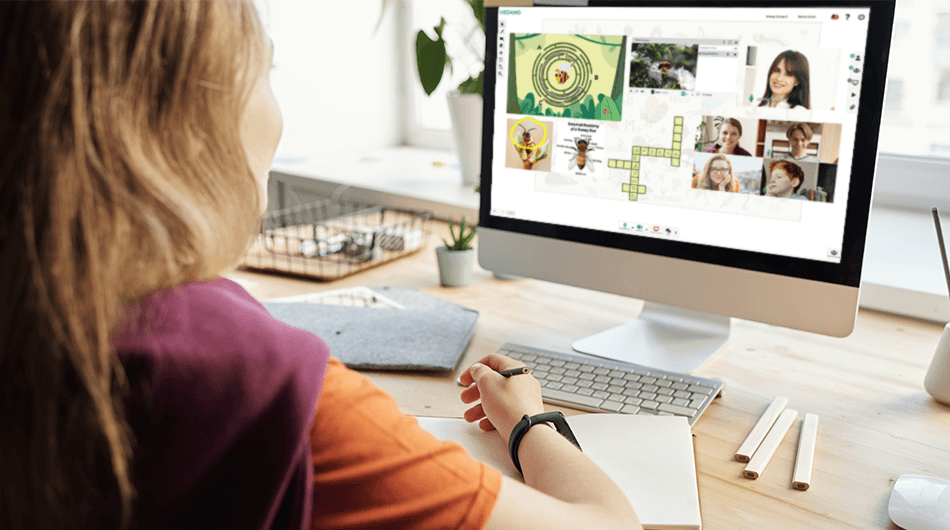How can you help your students enjoy the learning process in the virtual classroom? The easy answer is: get them more engaged in the lessons! However, this advice is easier said than done, especially when teaching in the reality of remote learning. The engagement of the students often varies depending on their age, the size of the class, their interests, the subjects of the lessons, and much more.
The more involved and interested they are in the learning process, the more effective the lessons are. Here are a few tips that can help teachers create a more engaging learning experience for their students in the virtual classroom:
- Make your students feel valued and included in the learning process
- Add activities with competitions and challenges
- Include collaborative activities for working in groups
- Embrace the micro-learning approach in the lessons
How can you create engaging learning activities for the virtual classroom using these approaches?
Give your students more control over the learning activities
Get students involved in the activities in the lesson in the virtual classroom. For example, ask for ideas for learning games and exercises that you can try on the online whiteboard. Incorporate more flexibility into the lessons by giving the students the chance to present different parts of the lesson by researching materials on certain topics, making presentations, etc. One of the best ways to engage students is to switch roles and give them the chance to take turns to teach different lessons on the online whiteboard. Also, ask for feedback.

It is important that students feel heard and included. The interactive activities in the virtual classroom can help improve the engagement of the participants by making them feel physically and mentally included in the lesson. These interactive activities might include drawing or doodling, playing games, participating in debates, and much more. The idea is to encourage students to be physically and mentally focused on the activities and be active participants in the learning process. In order for students to feel included, it is recommended to make sure that every student speaks regularly during the lesson.
When planning the lessons, create options for your students so they can choose which activities to do more of, what assignments to work on, etc.
Add a pinch of competition into the mix of activities
The activities that are based on competition are a sure recipe for success when the goal is to improve student engagement. How can you incorporate such exercises in the virtual classroom? The easiest way to increase the level of fun and to make students more enthusiastic about the lesson is by playing games. Divide the class into groups and play learning games like crossroads, trivia quizzes, Pictionary, etc. The online whiteboard, combined with the videoconferencing and live chat features in the virtual classroom, make it possible to play games together in real time during the lesson.
Online debates are another way to spice up the learning process and keep the focus of the students on the topics. Choose the topic for the debates together with the students and then divide them into teams that will support the different sides of the debate. The breakout rooms in the virtual classroom are a wonderful virtual space for the teams to prepare for the debates. After each group of students is ready for the activity, everyone joins the virtual classroom for the debate in real time. To make it even more interesting, choose a third group of the class that will play the role of the jury.
Teamwork and collaboration are key
The spirit of teamwork can be a real boost to the motivation and engagement of the students. There are tons of learning activities that teachers can incorporate into the lessons using the features of the virtual classroom for this purpose. The exercise “Think, Pair, and Share” is an awesome way to combine collaboration with competition in the classroom. The breakout rooms in the virtual classroom are the perfect online space for the divided teams to work on the assignment by brainstorming on the online whiteboard and making notes in shared documents. At the end of the session, the whole class gathers together in the virtual classroom and shares their completed work.

The assignments might vary from tasks for researching to more creative exercises like storytelling. It is important that every student contributes to the assignment. Thanks to the features in the virtual classroom for making notes, taking screenshots, etc., it is easier to follow the sessions of the teams in the breakout rooms.
One of the advantages of using an online whiteboard for the lessons and the teamwork activities in the virtual classroom is the ability to incorporate diverse content, including text, presentations, images, audio, and video. The abundance of resources and materials corresponds to the different learning styles of students. The easier the lesson is to understand, the more engaged students are in the learning process.
Less is more
One of the challenges that online learning creates is the shorter attention span of students. Incorporate the micro-learning technique into your teaching to make the lessons easier to digest and the learning experience more effective. The virtual classroom offers the perfect environment for rotating learning sessions with more relaxed exercises like playing games, drawing, storytelling, fun breaks for creative activities, quizzes, working in group assignments in the breakout rooms, etc. Chunking content is a successful technique for teaching new material, especially when teaching more complex concepts.
Longer lessons tend to be more difficult to understand because of the shorter attention span of students, which leads to decreased motivation and engagement in the activities. Incorporate various media in the lessons and use presentations with bullet points to make the content more organized and easier-to-understand for students.
Storytelling
Finally, the best way to increase student engagement is to use the power of storytelling. The most interesting stories are among the most powerful techniques for learning new material, enriching student creativity, and improving their ability to express themselves. There are many ways to incorporate storytelling into the learning process. For example, you can be the storyteller and present the lesson by telling an exciting story. You can encourage students to share their own stories related to the lesson. Writing a story together is also a great way to improve teamwork and to boost creative thinking. In the virtual classroom, it is easy to use different types of content to make storytelling even more engaging, like including pictures, drawings, videos, audio, etc.
When the lessons are enjoyable and interesting to the students, time flies and they learn even while having fun in the virtual classroom. Keep the content fresh and inspiring for your students and incorporate the element of surprise to make them excited about future activities and assignments.
